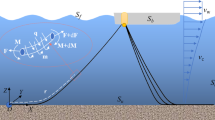Abstract
Motion responses of the floating liquefied natural gas (FLNG) hull and the mooring loads in a 100-year return environmental condition are predicted with the help of the well known coupled dynamic analysis code DeepC. A ship-shaped turret-moored FLNG moored by 4×3 chain-polyester-chain lines in 1.5 km depth of water is studied. Two types of turrets such as internal and external turrets, resulting from different locations of the turrets, are adopted respectively in the numerical simulations. Motion responses of the FLNG hull and forces of the mooring lines obtained from the internal turret case and external turret case are compared with each other. Significant differences are obtained. Statistic analysis is also used to analyze the comparison results, and effects of the turret location on the FLNG hydrodynamic characteristics are summed up. The conclusion regarding the hydrodynamic differences between internal and external turret-moored FLNG systems would provide help for design of the FLNG system.
Similar content being viewed by others
References
Kim J W, Jim O S, Atle S, et al. Global performance and sloshing analysis of a new deep-draft semisubmersible LNG FPSO [C]// Proc 27th International Conference on Offshore Mechanics and Arctic Engineering. Estoril, Portugal: ASME, 2008: 881–889.
Mravak Z, Lauzon J D, Chung Y S, et al. Strength assessment of membrane LNG tank structure based on direct calculation of structural response [C]// Proc 28th International Conference on Offshore Mechanics and Arctic Engineering. Hawaii, USA: ASME, 2009: 767–774.
Graczyk M, Moan T. Structural response to sloshing excitation in membrane LNG tank [J]. Journal of Offshore Mechanics and Arctic Engineering, 2011, 133(2): 103–111.
White J, Longley H. FLNG technology shows promise for stranded gas fields [J]. Offshore, 2009, 69(11): 78–79.
Wichers J EW. A simulation model for a single point moored tanker [D]. Delft, the Netherlands: Delft University of Technology, 1988.
Sphaier S H, Fernandes A C, Correa S H. Maneuvering model for the FPSO horizontal plane behavior [C]// Proc 20th International Offshore and Polar Engineering Conference. Seattle, USA: ISOPE, 2000: 334–337.
Lee D H, Choi H S. A dynamic analysis of FPSOshuttle tanker system [C]// Proc 20th International Offshore and Polar Engineering Conference. Seattle, USA: ISOPE, 2000: 302–307.
Munipalli J, Pistani F, Thiagarajan K P, et al. Weathervaning instabilities of a FPSO in regular waves and consequence on response amplitude operators [C]// Proc 26th International Conference on Offshore Mechanics and Arctic Engineering. San Diego, USA: ASME, 2007: 405–412.
Lee S J. The effects of LNG-sloshing on the global responses of LNG-carriers [D]. Texas, USA: Texax A&M University, 2008.
Salvesen N, Tuck E O, Faltinsen O M. Ship motions and sea loads [J]. Transcations of the Society of Naval Architects and Marine Engineers, 1970, 78, 250–287.
Luo Y, Baudic S. Predicting FPSO response using model test and numerical analysis [C]// Proc 13th International Offshore and Polar Engineering Conference. Hawaii, USA: ISOPE, 2003: 167–174.
Moriskita H M, Junior J R D S. Dynamic behavior of a DICAS FPSO and shuttle vessel under the action of wind, current and waves [C]// Proc 12nd International Offshore and Polar Engineering Conference. Kitakyushu, Japan: ISOPE, 2002: 142–150.
Garrett D L. Dynamic analysis of slender rods [J]. Journal of Energy Resources Technology, 1982, 104(4), 302–307.
Riarald O, Elizabeth P. Riflex theory manual [R]. Tronheim, Norway: Det Norske Veritas, 2005.
Kannah T R, Natarajan R. Effect of turret location on the dynamic behaviour of an internal turret moored FPSO system [J]. Journal of Naval Architecture and Marine Engineering, 2006, 3(1): 23–37.
Author information
Authors and Affiliations
Corresponding author
Additional information
Foundation item: the China National Significant Science & Technology Research Program (No. 2008ZX05026-006)
Rights and permissions
About this article
Cite this article
Zhao, Wh., Yang, Jm., Hu, Zq. et al. Numerical investigation on the hydrodynamic difference between internal and external turret-moored FLNG. J. Shanghai Jiaotong Univ. (Sci.) 18, 590–597 (2013). https://doi.org/10.1007/s12204-011-1202-8
Received:
Published:
Issue Date:
DOI: https://doi.org/10.1007/s12204-011-1202-8
Key words
- turret-moored floating liquified natural gas (FLNG)
- hydrodynamics
- numerical simulation
- statistic analysis




